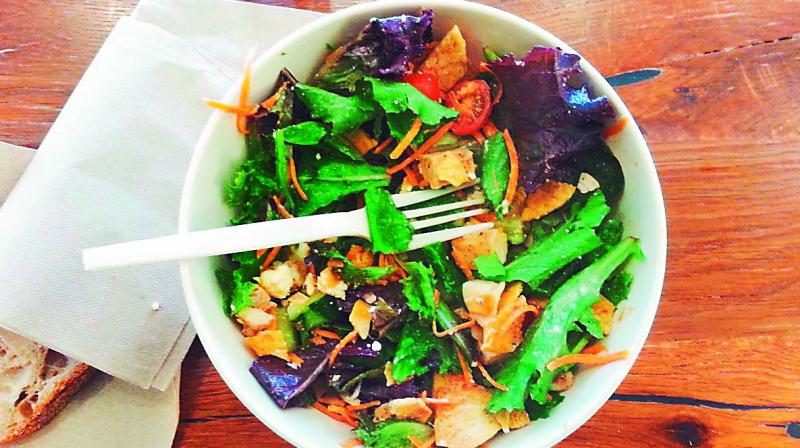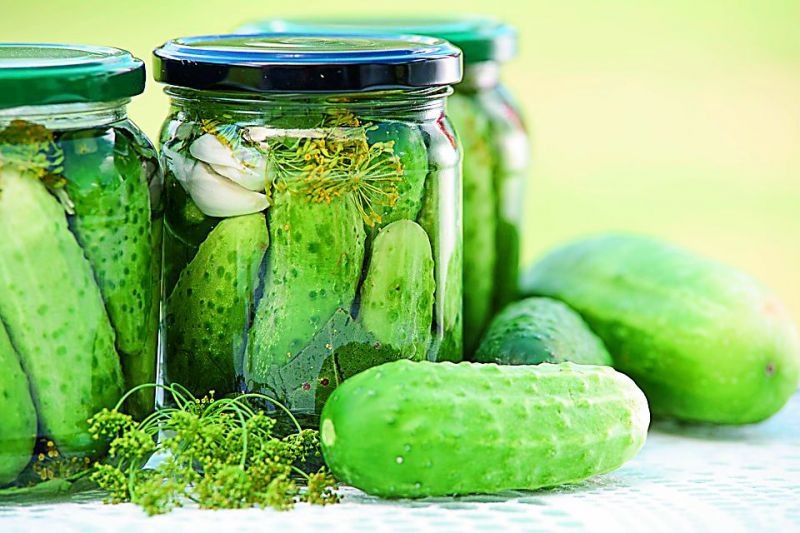Trash cooking
Root-to-stem or trash cooking is the new trend that aims to tackle food wastage and introduce a new creative spark for gastronomy experts.

Fancy making a meal out of leftovers in the dustbin? The idea may not quite whet your appetite at first, but it sure has chefs across the world scrambling for creative inputs and sparks of inspiration towards making ‘trash’ edible — and hence was born trash cooking. Uncooked food forms a large proportion of waste generated across the globe, contributing to a growing environmental crisis. According to the UNDP, around 40 per cent of waste generated in India is food waste. Dearth of mindful cooking practices which use the entire produce, Instagram aesthetic taking precedence over waste reduction and ignorance about nutritional value of discards contribute to increasing wastage of food, even before the cooking process begins. In India, new-age restaurants as well as established ones are slowly warming up to the idea, with a stringent eye on reducing food waste. With the mantra of ‘throw nothing away’, the proponents of root-to-stem or trash cooking are doing their best towards making our palates accept what we’d normally consider garbage!
Turning back the clock
Root-to-shoot cooking is an age old procedure, followed meticulously in our homes till a few decades ago. But later, due to busy lifestyles and misconceptions about nutrition, people forgot the importance of using all parts of the produce. “I grew up in a household where a separate ghiya (bottle guard) peel subzi was made (usually paired with sprouts) along with the main ghiya subzi, potato was always cooked with the peels on, and whenever gobhi parantha was on the menu, we knew that a delicious cauliflower stems (danthals) khatti meethi curry will be served in the next meal,” reminisces Kavita Devgan, nutritionist and author of Don’t Diet! 50 Habits of Thin People.
Thanks to all the peeling and scraping, we end up using less than half of most vegetables and fruits we buy to eat and cook. Mumbai-based chef and mixologist Arina Suchde recommends this concept in today’s scenario. “Not only in restaurants, at homes too one should be careful about what is thrown away. There was a generation that used everything that was edible in their cooking. They made sure that nothing went waste.” While there are various names for this concept, the one Chef Ajit Bangera of ITC Chennai dismisses is ‘trash cooking’. “I don’t understand why they call it trash cooking. Firstly, you need to forget the idea that the vegetable off-cuts are trash! Then it makes things easier,” he says. According to artisan baker and Master Chef Season 5 finalist, Shipra Chenji, a vegetable should be treated as a whole entity. “Unless it is not really good for health, nothing should be wasted. And I believe that all parts are edible and good for health.”

Growing food waste
Well, the list is long. But let’s just focus on three aspects — less awareness, mindless and fancy cooking. Cooking consciously can definitely reduce the amount of food that goes waste. To tackle food waste, we need to consume the whole vegetable. “Most people don’t think about what goes into waste. There should be a deliberate effort to lessen the food garbage,” Shipra says. In hotels, the aesthetic appeal of food presentation is considered very vital. This results in much wastage. “The chef chops and slices and makes it look pretty and fancy. And oh yes, that’s what the Instagram generation wants. Whom to criticise here?” Arina asks. “In bars, fresh ingredients are used to make concoctions as this makes for better finished drinks. This results in huge wastage as bartenders usually extract the pulp or desired flavours from the fruits or vegetables and the rest is usually discarded,” says mixologist Himanshu Desai.
Nutritional gains
Root-to-shoot cooking is a brilliant way of ensuring macro and micronutrients in your diet. Consumers usually forget the fact that the peels and leaves we throw away are loaded with nutrients. “Instead of realising this, people run to stores to get their synthetic supplements. Either people are not aware of this or they are too busy to spend extra time in their kitchen,” mentions Arina.
“The thick peels, roots, stems and seeds that we trash are loaded with nutrients that are very hard to find. Maximum fibre and antioxidants are packed in these discarded parts. They are a rich source of dietary fibre, also known as NSP (non-soluble polysaccharides) like hemi-cellulose, pectin and more. These compounds increase the bulk of the food and help prevent constipation, cut colon cancer risk and help lower serum LDL cholesterol levels. Plus, they are universally low in calories, sugar, and fats; and free from cholesterol, and add satiety and help cut down overall food intake (read help in weight control),” says Kavita. Chef Anand Kumar suggests using all trimmings of vegetables or fruits because of their nutrients content. “The outer skins of fruits and vegetables are filled with flavour and vitamins. Whenever we use any vegetable, we try to utilise almost all parts of the vegetable in various stages. This is being practised in almost all food industries to control the food cost,” he says.
Educating consumers
Supporters of root-to-shoot cooking say that educating producers and consumers about nutritional properties and cooking techniques is vital. Arina conducts workshops across the country, propagating this idea. “Only few people are bothered about their health and the environmental aspect. These days, due to their busy lives, people don’t care much about what is going to waste,” Arina says. Chef Ajit believes that wasting food is a crime. “It is sad to see how much food is wasted. We can be a little more conscious and get back to our roots. Not just for the environment, it would be good for our health too.”
Many shy away from the process as they think it is time-consuming. “Honestly, it will not take much additional time from your usual kitchen routine. And it is not a big task either. You just need to remember to save the stock. That’s it,” says Arina, adding, “Though it makes a difference, at home the food quantity is very small. But in hotels, if they can incorporate this concept, it will definitely make a difference. More hotels should come forward and practice this. And chefs should find ways to add this in their menu.” Anand suggests ways through which hotels can control food wastage. “Innovative or centralised menus (if more than one food serving outlets), an award programme for wastage control measures, small bin day where the working section will have small bin to throw wastage. Also, keep in mind — the smaller menu is but the best. Creative menu writing will make a consumer aware of the dish. You can also have a brief write-up about the wastage control in preparing a particular dish.” An effective way to spread awareness is by restaurants and chefs cooking more such dishes. “We can go back to our roots (literally) and begin making the fabulous Andhra cucumber pickle in which the peels are left on, the watermelon rind chutney, or the ash gourd chutney… all ingenious ways to use it, I say! And delicious to boot!” says Kavita.
Getting started
The beginner should be trained properly on how to process and cut fruits and vegetables, and continue the trend until it becomes a part of their routine. Don’t throw away any leaves, greens and stalks. If you don’t know what to do with them, just put them away in the freezer, and keep doing that till you have enough to make a super healthy vegetable stock. “Some people are peelers, some people aren’t. Some people swear by the nutrients and fibre found in produce skins, others shy away from the taste or texture, or prefer removing the outer layer to reduce pesticide load. Regardless of your peeling preferences, citrus rinds, potato and other root/tuber peels, scooped-out avocados, and even cheese rinds all have more than one life,” Anand explains.
Rustle up a feast
There are many innovative ways to control wastage and use the entire produce — be it a fruit or vegetable. Try and utilise almost all parts of it in various stages. Were you about to throw away the tops of those leeks? What about those broccoli stems? We often toss the tough roots, stems and leaves of vegetables which are not only totally edible, but also offer nutrients and sometimes better flavour. Just like some butchers use all parts of the animal, many cooks are avoiding food waste by making use of vegetable scraps. “Try this very basic recipe of beet greens pesto that I make at home — just whirl in a food processor, beet greens, garlic cloves, walnuts, grated parmesan, salt and black pepper. Mix in virgin olive oil. A friend makes it with carrot greens instead,” shares Kavita. Chef Ajit Bangera says that the roots and skins of most produce such as potatoes, beetroot, carrots, egg plants, tomatoes, lemon, orange etc can easily be dehydrated and used to decorate food or made into crisps. “There is no better bar snack than potato peel chips. Some people remove the tomato peel, and rather than throwing it away, dehydrate it, and grind it into a powder which can be used for garnishing. Similarly, eggplant skin makes nice edible garnishing. Carrot heads can be blitzed and used in smoothies and soups.”
If you aren’t sure about what to do with the scrap, put it in the freezer. “No one will ever believe that onion skin can be good for stock. Coriander stem is excellent for marination of kebabs. Instead of discarding the stems, you can blend it and make coriander juice. Coriander stem can add crunch and zing to food. Spring onion peel is used in Chinese cooking. It has a flavour and a good appearance as well,” says Ajit. In Shipra’s kitchen garden, there are a lot of weeds that grow beside the vegetables. “They are rich in micronutrients and I use them in the palaks. They usually come from the bird droppings or sometimes these weeds are dormant in the soil and keep growing when they get the right nutrients. Beetroot leaves in palak dal give it a nice taste. If you are making smoothies, why don’t you add some carrot leaves? It is appetizing and nutritious,” she says. Himanshu never throws away the leftover peels after making a fruit-based concoction. “When preparing orange and grapefruit-based concoctions, once the juice is extracted, I dehydrate the leftover peels, churn them into a fine powder and use it to prepare flavoured caster sugar for rimming cocktail glasses,” he says.
There are no side-effects. “But some people complain of stomach upset. It is actually cleansing your stomach. When you have a whole vegetable, it helps you excrete better and you will understand your digestion,” Shipra mentions. Kavita says that she has eaten some fabulous dishes at restaurants and some enterprising chefs are taking the initiative. “They are incorporating stems, flowers and shoots in their mainstream menus. I remember eating a fabulous dish Mochaar Ghonto made by Chef Vikramjit Roy with banana blossoms, and recently also came across some fabulous recipes by chef Alexander Moser of Andaz Delhi. But yes, more restaurants can definitely take this up in a bigger way. This is quite welcoming.”
Using kitchen scraps.....
Apple peel
Make jelly: Any apple peels will do, but red coloured ones make an especially lovely jelly.
Add to oatmeal: Store peels in the freezer and add them to simmering oatmeal along with raisins and cinnamon. For a finer texture, process the peels in a blender first.
Add to smoothies: Throw some frozen apple peels into a smoothie for extra fibre.
Clean aluminum cookware: The acid in apple peels can remove stains and discoloration from aluminum pots and pans. Fill the pan with water, add apple peels, and simmer for about 30 minutes.

Orange peel
Make candied peels | These are great to munch on their own or as a garnish on top of cakes and parfaits. You can also dip them in chocolate for an extra-special treat.
Dry and save for tea | Dried peels make a nice addition to your basic cup of black tea. We also like to use them in our homemade chai tea mix this time of year. Scrape away as much of the bitter pith as you can and leave the peels in a single layer on a plate or drying rack for a few days.

Add to meat dishes | A hint of citrus will enhance many meat dishes. Throw the peels in the braising liquid or put them in the cavity of a whole chicken before roasting.
Infuse liquor | Citrus-infused vodka makes for an excellent cocktail. Don’t spend money on flavored vodka when it’s so easy to make your own: just steep citrus peels in liquor for a few days. The bright peels are beautifully suspended in the jar, where all the magic is happening.
Cook it up!
Mushroom Stems
The tender caps of shiitakes and porcinis make for elegant main dishes — from Wild Mushroom Pappardelle with Mascarpone to Mushroom Miso Pot Pie — but the woody stems aren’t useless. You can finely chop them to make duxelles — a delicious mix of sautéed mushrooms, herbs and onions that makes a killer topping for crostini — pickle them for sandwiches, or simmer a big batch for an earthy vegetable stock.
Onion, Leek and Scallion Extras
Onion skins and the dark green parts of leeks and scallions are gold when it comes to making stock. Onion skins will turn your broth a deep amber shade, a sign of its concentrated flavour. (The skins should be unblemished.) Tops of leeks can be too sinewy to enjoy on their own, but they lend an almost buttery taste to simmered soups. While the dark green parts of scallions are perfectly edible, some recipes call for only the white parts. Save the green tops for garnishing salads and soups. One way to preserve all these trimmings is to transfer them to a freezer bag until you’ve amassed around 4 cups, and then use them as the base for soup.
Celery Roots and Leaves
Celery roots and leaves are typically tossed without a second glance before they ever reach supermarkets. If you do see celery stalks with their leaves attached, snatch them up. The leaves look a lot like parsley, and you can use them the same way — as a herb to garnish any celery recipe — or as added roughage in a salad. You can also save the leaves for stock or sauté them with other aromatics, which works particularly well in French dishes. The celery root tastes like a mashup between celery and potato. You can julienne the root and turn it into a mayo-dressed slaw or cook and mash it.
Radish, Turnip And Beet Greens
we turn to these vegetables for their crisp and healthy roots, but they also sprout greens, which you don’t want to miss. Radish greens possess the root’s typical spiciness, while turnip and beet greens are a bit more mild. Sauté all three as you would spinach or chard, in olive oil and garlic.
Herb Stems
Most recipes call for you to pluck herbs from the stem, which we then toss. But the stems of cilantro, mint and parsley are especially tender. Mince them and add to any recipe containing their leaves (usually when you’re cooking aromatics). Herb stems can be blended and turned into pesto, salsa verde, or compound herb butters. Woody rosemary and thyme stems won’t ever get that tender, but you can always throw them into stock.
Corn Cobs
when submerged in simmering water, corn cobs turn into a milky broth that’s an ideal base for corn chowder or any summer vegetable soup. Once you’ve stripped the cobs of their kernels, simply transfer the cobs to a pot, cover with water, and simmer until the broth tastes sweet.
Broccoli And Cauliflower Stems
Broccoli and cauliflower stems sometimes offer a sweeter flavour than the florets. To use them, slice the stalks and peel the tougher skin near the bottoms. Try them in your stir fry or cook the stems in boiling water with a few garlic cloves and mash for a healthy alternative to mashed potatoes.
Potato Skins
Ever ordered potato skins at a pub? You can make them at home, only with scraps. Before peeling potatoes (any variety, including sweet potato, works), scrub the skins well and remove any eyes or blemishes. Fry the shavings in a hot skillet greased with olive or coconut oil until crackly, then season generously with salt. You can serve skins alongside eggs as an alternative to hashbrowns or as a garnish on any potato dish, such as potato leek soup.
Fennel Roots, Stalks And Fronds
Fennel is a prized plant in that every part is both edible and delicious. The needle-shaped fronds have a mild anise flavour, which makes them a perfect garnish for soups or addition to salads. As with celery, the root ends, outer leaves, and upper stalks of fennel will contribute body to soups and stews. Store fennel trimmings with those of leeks and onions in the freezer until you’re ready to cook them.
Watermelon Rinds
An American classic, crisp and tangy watermelon rinds complement almost any Southern dish. To prep them, remove the pink flesh and outer green skin, then submerge the remaining white rind in a brine of salt and sugar (dissolve salt and sugar in boiling water and vinegar, then add flavourings like cloves and whole peppercorns). Chill rinds for a few hours and up to a few weeks before serving.

